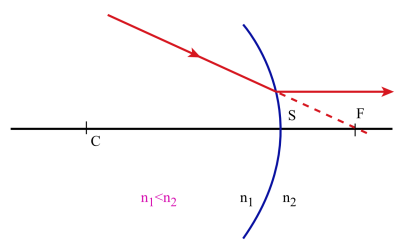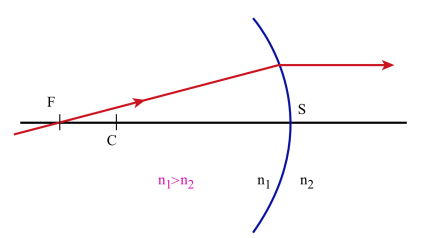Foyer objet


Si l'on définit le foyer objet[2] F comme étant le point de l'axe dont l'image[3] est située à l'infini sur l'axe on pourra considérer que CA2 et SA2 sont peu différents et la relation :
\(\mathrm n_1~\frac{\overline{\mathrm{CA}_1}}{\overline{\mathrm{SA}_1}}=\mathrm n_2~\frac{\overline{\mathrm{CA}_2}}{\overline{\mathrm{SA}_2}}~~\)
peut s'écrire : \(\frac{\overline{\mathrm{SF}}}{\overline{\mathrm{CF}}}=\frac{\mathrm n_1}{\mathrm n_2}\)
soit encore : \(\overline{\mathrm{SF}}=-\overline{\mathrm{CS}}~\frac{\mathrm n_1}{\mathrm n_1~-~\mathrm n_2}\)
cette quantité notée f est la distance focale objet du dioptre sphérique.
Dans le cas du dioptre concave : \(\overline{\mathrm{CS}}>0\)
si \(\mathrm n_1\) < \(\mathrm n_2\), F' est virtuel
si \(\mathrm n_1\) > \(\mathrm n_2\), F' est réel
Un rayon incident passant par le foyer objet du dioptre se réfractera en un rayon parallèle à l'axe optique du dioptre.
On a d'autre part :
\(\overline{\mathrm{CF}}=\overline{\mathrm{CS}}~+~\overline{\mathrm{SF}}=\frac{\mathrm n_2}{\mathrm n_1~-~\mathrm n_2}\overline{\mathrm{CS}}=-\overline{\mathrm{SF'}}\)
\(\overline{\mathrm{CF'}}=\overline{\mathrm{CS}}~+~\overline{\mathrm{SF'}}=\frac{\mathrm n_1}{\mathrm n_1~-~\mathrm n_2}\overline{\mathrm{CS}}=-\overline{\mathrm{SF}}\)
On constate alors que les foyers image et objet du dioptre sont symétriques par rapport au milieu de CS.